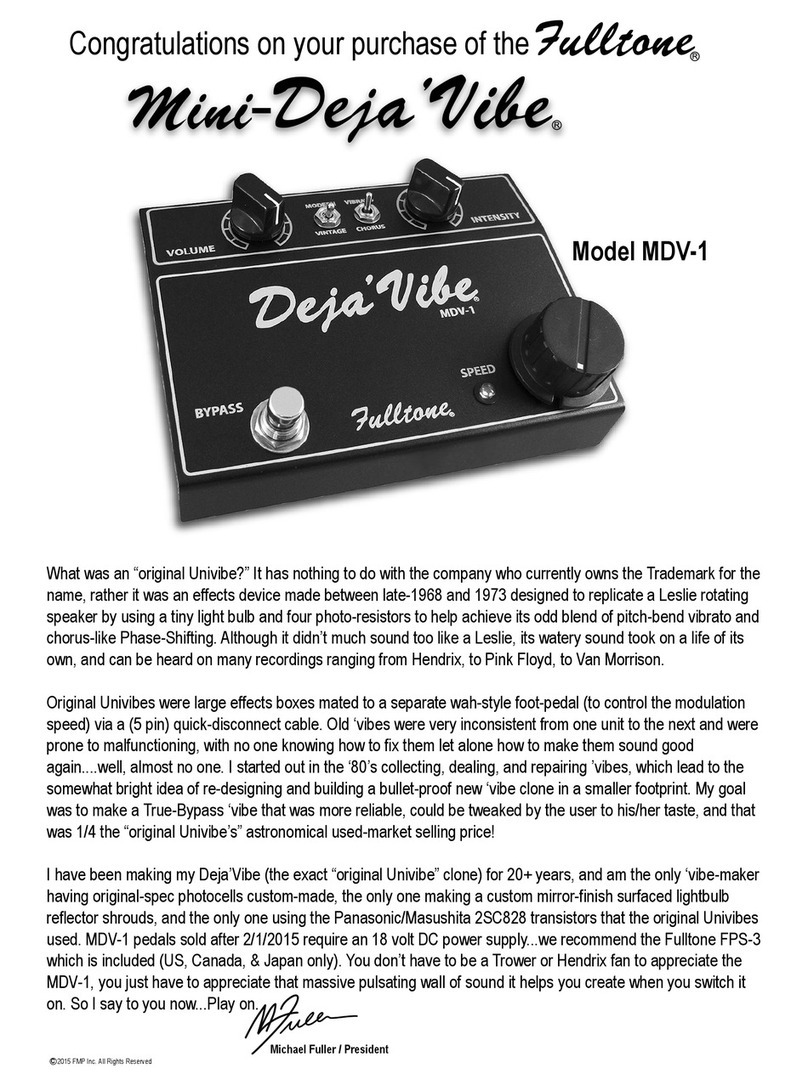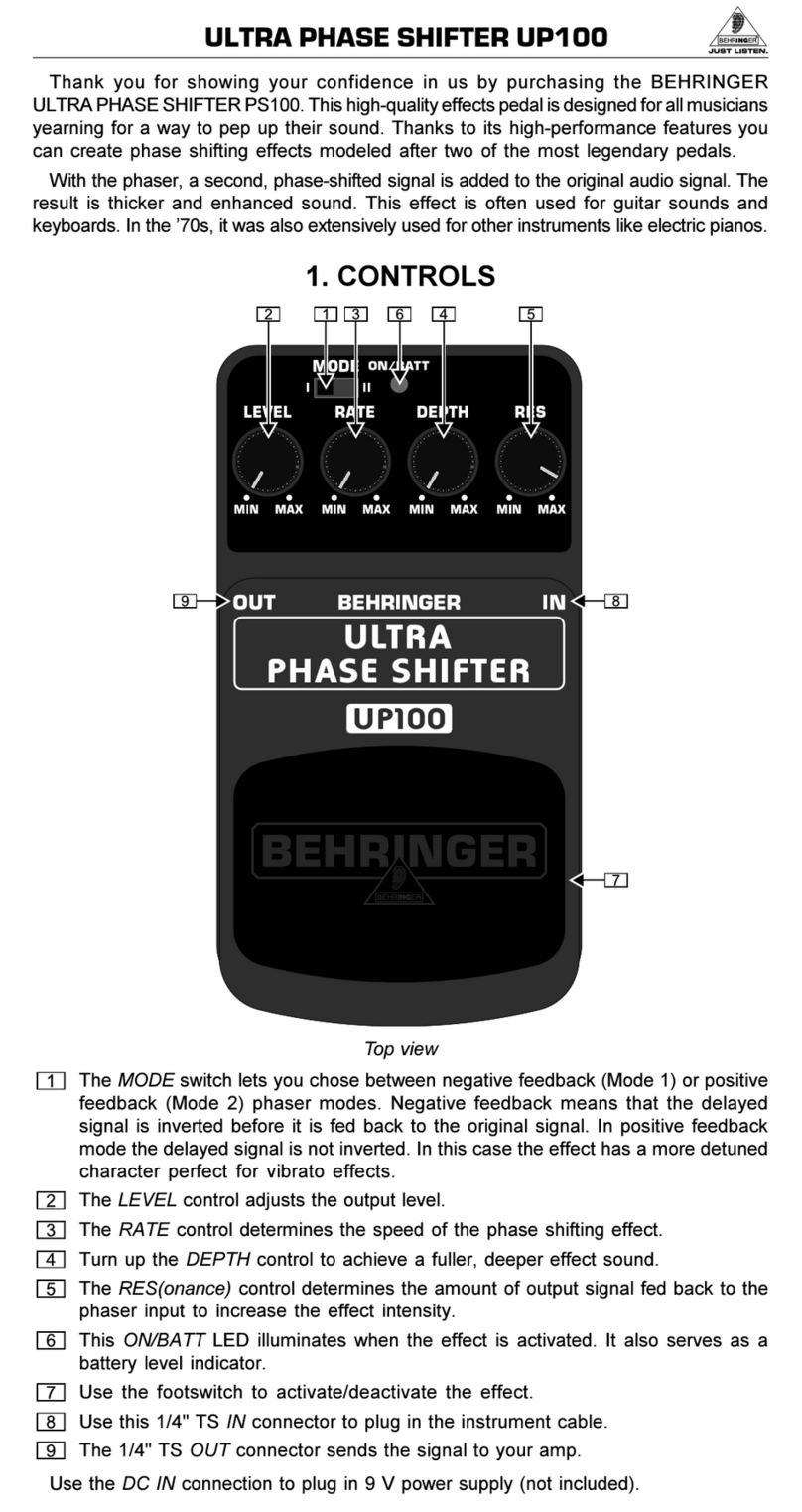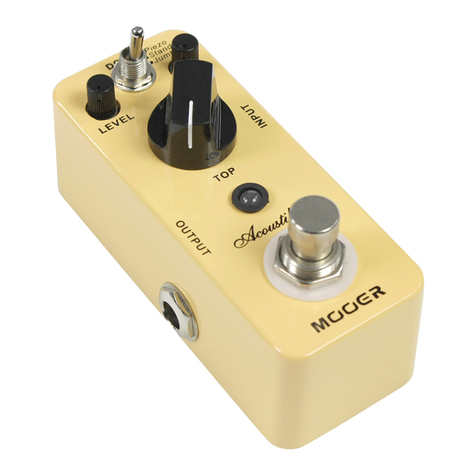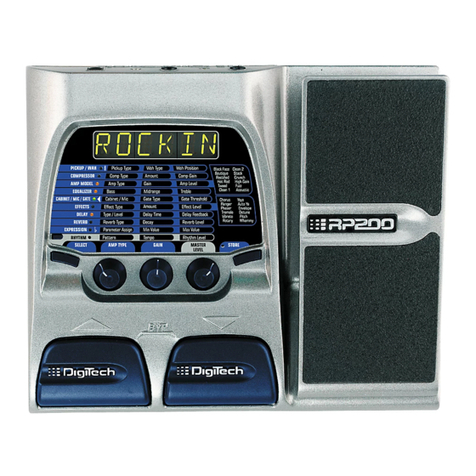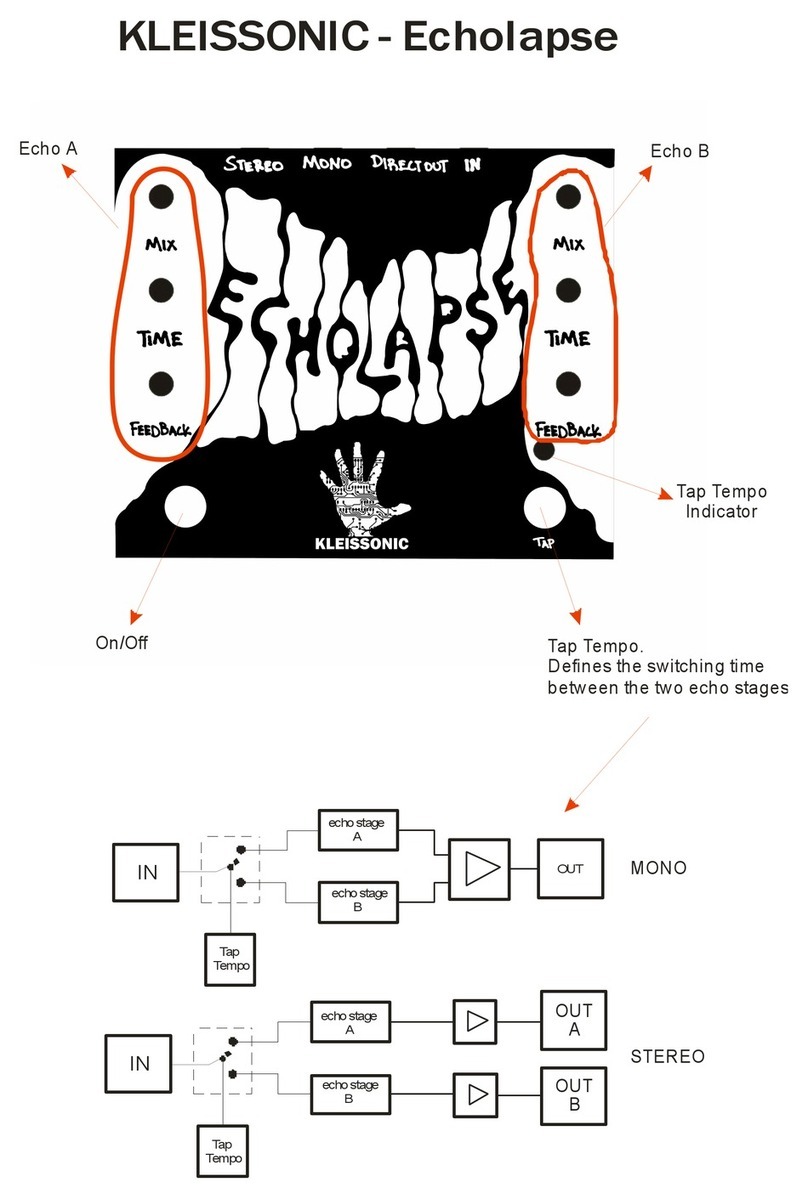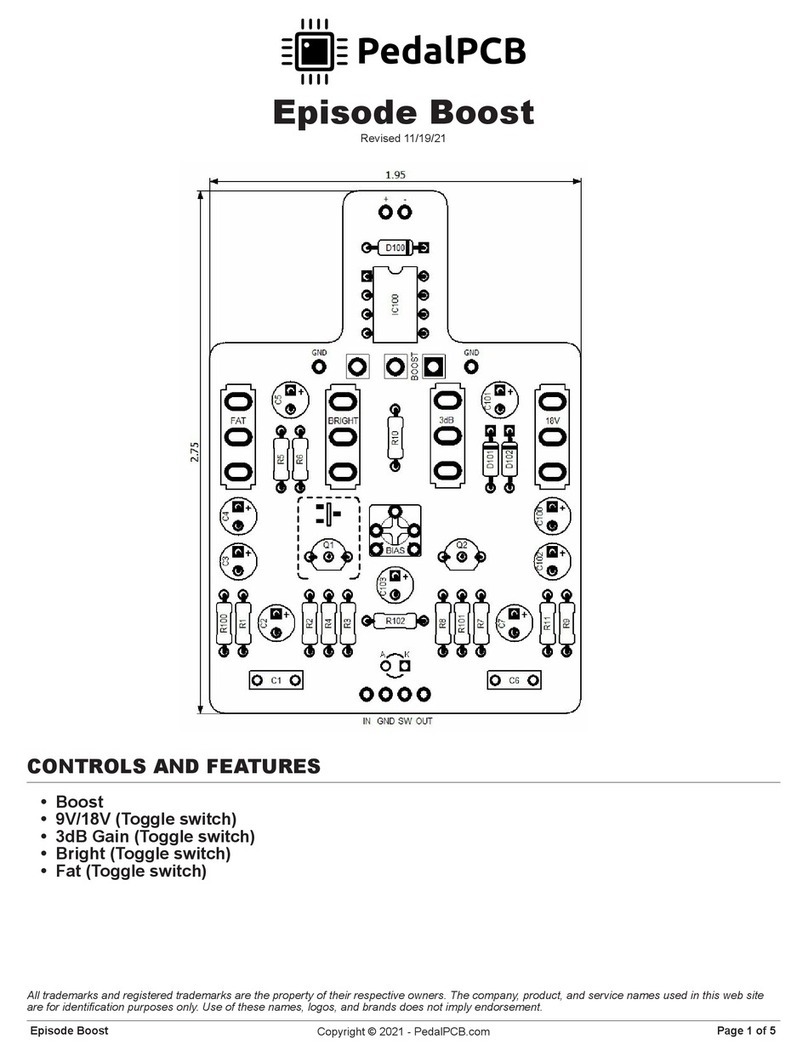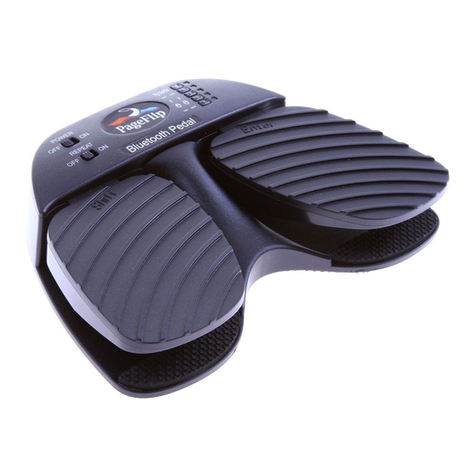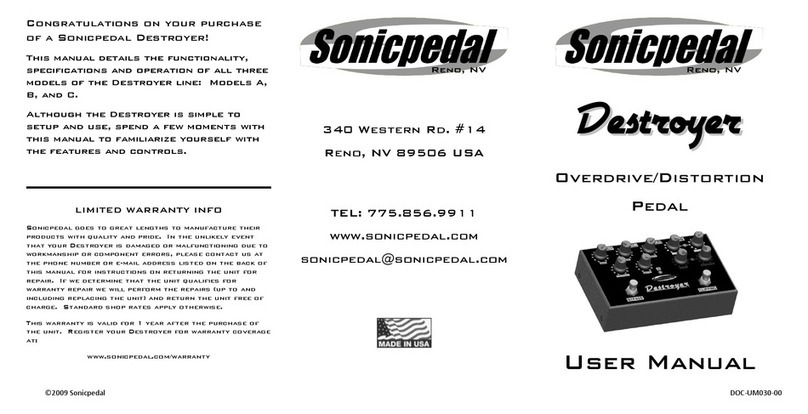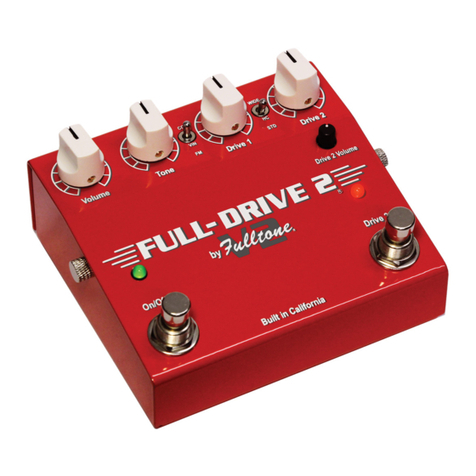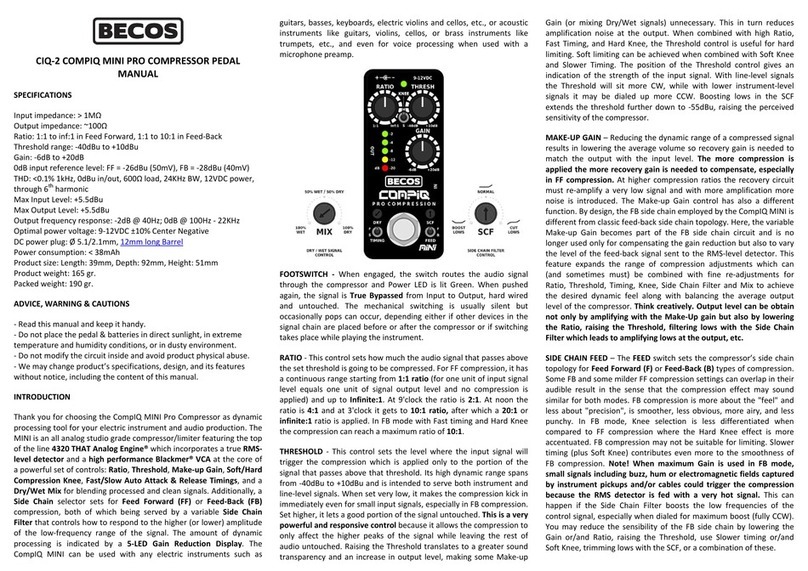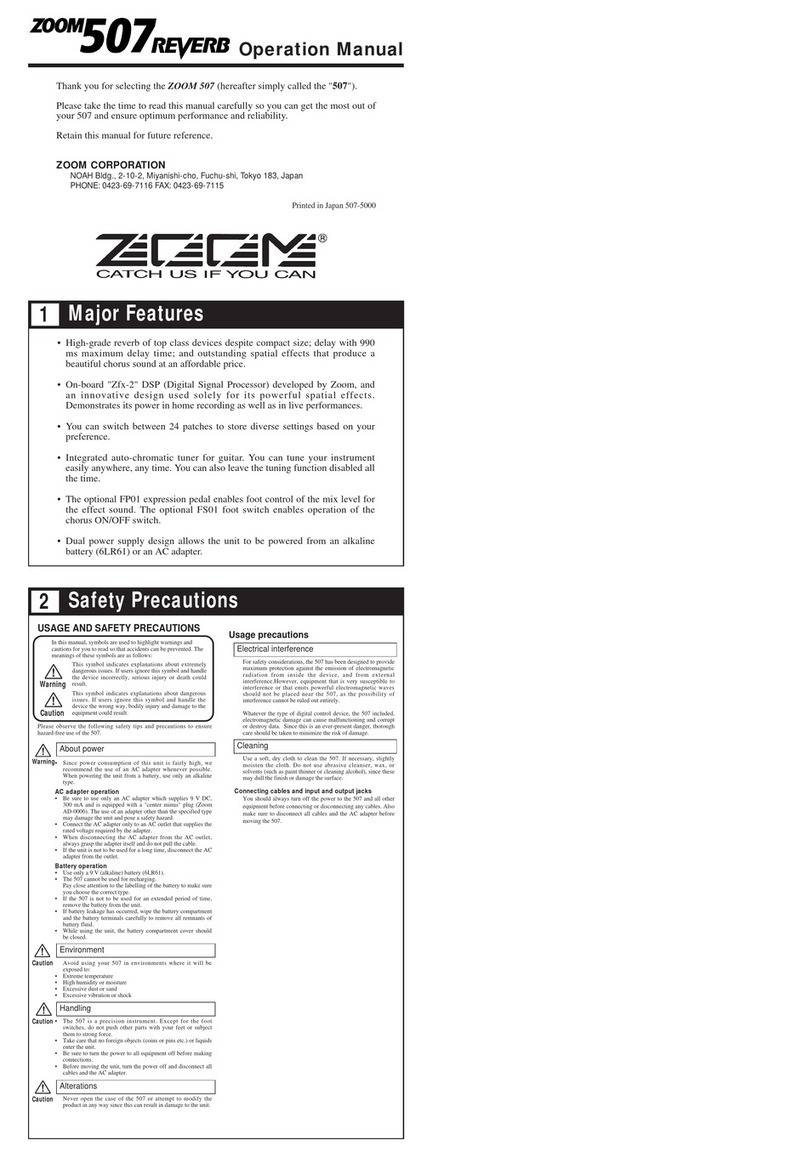Tronographic Rusty Box User manual

Rusty Box
Bass Preamplifier
The Tronographic Rusty Box is an instrument pre-amp in effect pedal format. Though optimized for bass guitar,
the Rusty Box is also effective on standard guitar. It is designed to re-create the unique 1970’s “hi-gain” solid-
state bass amp tone whilst adding useful modern features such as balanced line out, true-bypass and Master
volume.
Features:
•Input Gain controls allow musicians to dial-in just the right amount of gain and drive
•Passive EQ includes separate Middle, Bass and Treble knobs, all tailored for bass guitar
•Boost Mode for extra volume/drive is activated with your foot
•Can be used as a DI box on balanced Main Out with capability of driving 600Ω
•True-Bypass: Input is connected to Main Out and nothing else
•Look for “9V” in the upper left corner. If found, required power is 9VDC/130mA on center-negative plug
Common Configurations
Rusty Box as an Effects Pedal:
The Rusty Box can easily be inserted into a chain of effects, in an effects loop or as a single effect before an
amp that has a pre-amp section. Connect your instrument or the output of the previous device to the Input
jack on the Rusty Box. Connect the Main Out jack on the Rusty Box to the input of the next device in your chain.
Use standard ¼-inch guitar cables for both connections in this configuration.
Rusty Box as a DI Box:
The Main Out jack on the Rusty Box outputs a balanced signal capable of driving a 600Ωload. As in the effects
pedal configuration, connect your instrument or the output of the previous device to the Input jack on the
Rusty Box using a standard ¼-inch guitar cable. For the Main Out jack, plug in a balanced ¼-inch TRS cable; this
type of cable is necessary to properly use the Rusty Box as a DI. The other end of the balanced cable can go
directly to a mixing board or similar balanced audio devices. Optionally you can also use the Rusty Box’s Line
Out jack to connect to a monitor amp near the musician (described below).
Rusty Box as a Pre-Amp for a Power Amp:
The Line Out jack on the Rusty Box outputs the unbalanced audio signal at full volume. This connection, made
prior to the Vol knob in the circuit, is perfect for driving a power amp with its own input volume control. As in the
two previous configurations, connect your instrument or the output of the previous device in the chain to the
Input jack on the Rusty Box then connect the Line Out jack to the input of the power amp. Use standard ¼-inch
guitar cables for both connections in this configuration.
Controls
INPUT GAIN Knob: sets the gain for the input amplifier stage in the Rusty Box. As you turn the Gain knob
clockwise, your signal will get louder and be driven harder. You can obtain distortion when this control is turned
above 9 o’clock and the BOOST function is activated. The Input Gain knob works in conjunction with the HI/LO
toggle switch located below it.
HI/LO Toggle Switch: This switch gives the Rusty Box the equivalent functionality of high and low input jacks on
an amplifier. Setting this switch to the HI setting is just like plugging into the high input jack; high impedance with
full signal amplitude. Setting this switch to LO is just like plugging into the low input jack; your input signal will be
attenuated and the input impedance is reduced. In short the HI setting is louder, the LO setting is lower in
volume with slight treble attenuation.
BOOST Footswitch and LED: When the Boost switch is activated, the gain of the input stage is boosted or
increased. The Boost footswitch can be used to give your sound extra volume and drive while playing your
instrument. Use the Boost footswitch to toggle in and out of Boost mode. When lit, the LED above the Boost

footswitch indicates that the Boost function is active. When Boost is inactive or the Rusty Box is in True-Bypass
mode, the Boost LED is off.
MID Knob: is part of the Rusty Box EQ section. Turning the Mid knob clockwise will increase the level of the
middle frequencies of your signal. To obtain a “scooped” sound turn the Mid control down, below 12 o’clock.
BASS Knob: also part of the EQ section, turning the Bass knob clockwise will increase the level of your signal’s
bass or low frequencies.
TREBLE Knob: is the last control in the EQ. Turning the Treble knob clockwise will increase the level of you signal’s
treble or high frequencies.
VOL Knob: is the master volume control, setting the output volume at the Main Out jack. The Vol knob has no
effect over the output volume at the Line Out Jack.
EFFECT Footswitch and LED: the Effect footswitch is used to toggle the Rusty Box between Effect mode and True-
Bypass. When the LED above the Effect footswitch is lit, the Rusty Box effect is active. When the LED is off, the
Rusty Box is in True-Bypass mode. In True-Bypass mode, the Input jack is connected directly to the Main Out
jack; the Line Out jack is therefore muted. In addition, the Main Out jack is unbalanced in True-Bypass mode.
Connections
INPUT Jack: is the audio input connection for the Rusty Box. Plug your instrument or the output of another effect
into this jack. The input impedance presented at the Input jack when Input Gain is set to HI is 250kΩ; when set to
LO it is 18kΩ.
LINE OUT Jack: is an unbalanced audio output at full volume. If using the Rusty Box as a pre-amp before a
power amp, you can connect Line Out directly to the power amp. The Vol knob has no effect on the signal at
the Line Out jack. To change the volume of the signal out of the Line Out jack, use the Input Gain knob, Boost
footswitch or HI/LO toggle switch. The Line Out jack is muted in True-Bypass mode.
MAIN OUT Jack (Bal/Unbal): is the main audio output jack. Main Out can be used as either a balanced output
– by plugging in a ¼-inch TRS cable – or as an unbalanced output – by plugging in a standard ¼-inch guitar
cable. The Vol knob adjusts the volume of the signal present at the Main Out jack only. In addition, the Main
Out jack is a high current drive output capable of driving a 600Ωload.
We recommend using the Main Out jack when using the Rusty Box as an effects pedal where its output
is sent to other pedals or to an amp with a pre-amp section.
In True-Bypass mode, the Main Out jack is unbalanced. When using the Rusty Box as a DI box we
recommend you do not switch to bypass mode, leave the Rusty Box in effect mode at all times.
9V PWR Jack: if you see 9V in the top left corner of your Rusty Box than your Rusty Box requires a standard
9VDC, center-negative, effects pedal power supply. The Rusty Box’s current draw is 130mA but we recommend
using a power supply that is capable of providing at least 150mA to the Rusty Box. The power jack can accept
voltages up to 12VDC; do not connect voltages greater than 12.5VDC to the power jack. The polarity of the 9V
Rusty Box’s power jack is center-negative.
Warranty Information
Tronographic will repair your Rusty Box free of charge due to manufacturer defect or if it is damaged during
further information.
Note: This equipment has been tested and found to comply with the limits for a
Class B digital device, pursuant to part 15 of the FCC Rules. These limits are
designed to provide reasonable protection against harmful interference in a
residential installation. This equipment generates, uses and can radiate radio
frequency energy and, if not installed and used in accordance with the
instructions, may cause harmful interference to radio communications.
However, there is no guarantee that interference will not occur in a particular
installation. If this equipment does cause harmful interference to radio or
television reception, which can be determined by turning the equipment off
and on, the user is encouraged to try to correct the interference by one or
more of the following measures:
- Reorient or relocate the receiving antenna.
- Increase the separation between the equipment and receiver.
- Connect the equipment into an outlet on a circuit different from that to which
the receiver is connected.
- Consult the dealer or an experienced radio/TV technician for help.
Modifications not expressly approved by the manufacturer could void the user's
authority to operate the equipment under FCC rules.
Table of contents
